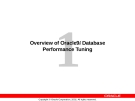16 trang
54 lượt xem
5
54
Overview of Oracle9i Database Performance Tuning
After completing this lesson, you should be able to do the following:
Define the roles associated with the database tuning process
Describe the dependencies between tuning in different development phases
Describe service level agreements
Identify tuning goals
Identify common tuning problems
Employ tuning activities during development
and production
Balance performance and safety trade-offs
trinh02


